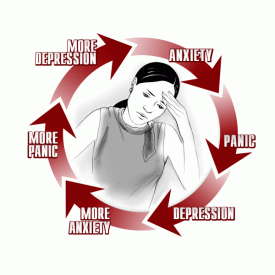For Immediate Release
Panic Attack!
Carlsbad Psychologist provides new way of understanding the frightening unpredictability of anxiety attacks, worry, and stress… The Aggregate Model of Anxiety-3 Steps
Carlsbad, CA
“Panic attacks: Anxiety attacks seem to come from nowhere, without warning, and at the worst times, leading many to think they are dying or having a heart attack. But the cause of the anxiety attack may not be what you think. Fear is to blame, but fear of what ?”
“…After more than a decade of treating people with anxiety and depression, the underlying factors of panic and anxiety attacks have been surprising.”
Dr. Jason N. Camu, Fuel-centers specializing in anxiety, Carlsbad, CA.
Where do Panic Attacks come from?
When no physical or medical cause is identified, many assume that a deep unresolved mental health issue must be confronted before panic can be alleviated. While this is often an essential part of lasting change, more immediate relief can come from a surprising place—A collection of many small, avoided responsibilities and conflicts must be dealt with, and/or completed. “I have seen panic attacks either disappear, or diminish significantly, when people begin working on even mundane responsibilities,” says Dr. Camu of Fuel for Emotional Health in Carlsbad, California. It’s not that panic is caused entirely by these little contributors, worries, or responsibilities; it’s that these nuisance burdens build, and finally tip the balance in the mind, overwhelming even intelligent, competent individuals.
And Procrastination is a major culprit.
Examples of such concerns can include unopened mail, unpaid/late routine bills, work tasks, paperwork, irritation with co-workers, schoolwork, car repairs, even seemingly enjoyable things like RSVPing for a party. The list of minor concerns/worries is of course personal to the individual, and ultimately progresses in intensity to include bigger responsibilities and anticipated conflicts with people.
The Aggregate Model of Anxiety
Aggregate: is a mixture of minerals, gravel, sand, and small rocks that are sometimes used as an additive ingredient, for example in making concrete. The composition of Anxiety can include the same structure—many tiny contributors like gravel, (responsibilities, errands, irritations, reoccurring tasks of daily living) that when combined with bigger stones and boulders (major life issues), produce anxiety or panic attacks.
It is these many seemingly inconsequential problems, concerns, and issues that grow to make a massive heap, perhaps difficult but somewhat manageable for a time, to later become a mountain of un-scalable proportion. It becomes very challenging to identify a tiny rock in a concrete sidewalk or the pebble in an asphalt highway, and even more difficult to understand it’s role in the overall product. Nonetheless, it’s obvious that each miniscule mineral plays a role in the function of the smooth surfaces we walk and drive on each day.
Treating the problem: Stop the panic!
For most entering therapy, the cause of anxiety is elusive or feels mysterious. After all, why be afraid to drive a car or go on an airplane? For many, these activities were completed successfully for years prior. The real cause of the root fear is often obscured or amplified by aggregate nuisance contributions. Sometimes people have an idea of what is causing the anxiety or panic attacks, but it is usually focused on much larger problems (boulders) in life (examples of boulders are things like divorce, family problems, trauma career/work troubles, and financial disasters, even losing one’s home). “Because boulders are usually harder to confront or change and require more work in therapy, for example walking out on your job or marriage, the pebbles or aggregate can be sifted, sorted, and categorized to be more readily resolved,” says Dr. Camu.
The 3 Step Method for Treatment
- Separate small problems (gravel) from big ones (boulders)
- Confront, complete, or address these manageable responsibilities
- Make real plans, NOT worries, to address larger scale problems in the future
When the parts that make up the sum total (first the gravel and stones) are identified and addressed, panic and anxiety can reduce much more quickly. What happens next may be quite liberating. Pebbles, or avoided responsibilities and problems, no longer occupy mental and cognitive space, nor do they use up valuable emotional energy with procrastination, worry, and fear in a person’s mind. The clarity that follows leads many to feel stronger, more in control, and able to begin addressing the formidable issues in life. Often the fear of having a panic attack vanishes and is even forgotten…
For more information regarding Fuel For Emotional Health services, go to http://www.FuelForEmotionalHealth.com.
You may contact Dr. Camu for further correspondence or interviews by telephone in the U.S., at 1.760.828.3835(FUEL), or Dr.Camu@FuelForEmotionalHealth.com.
Fuel for Emotional Health, specializing in anxiety and located in Carlsbad, CA may be able to help.
###



